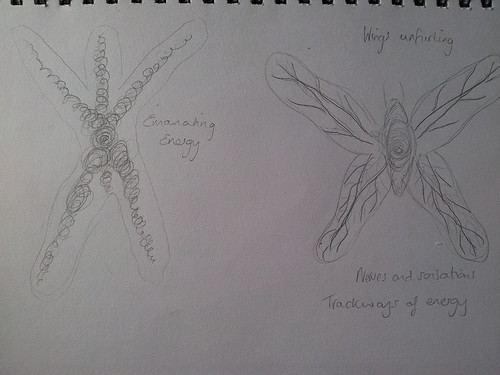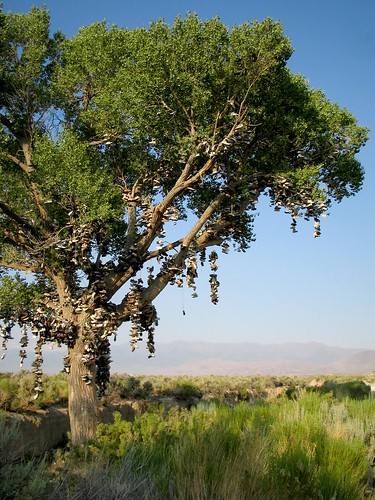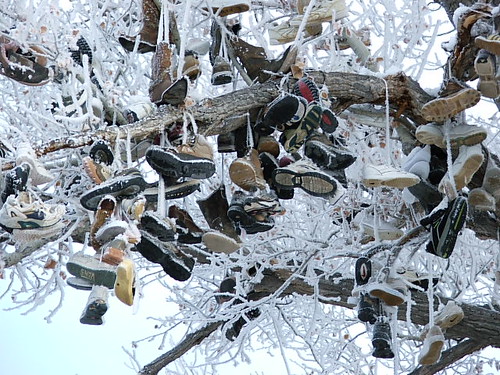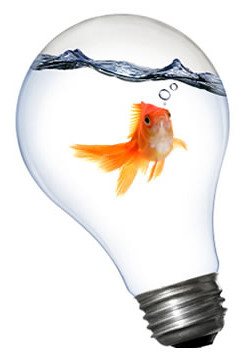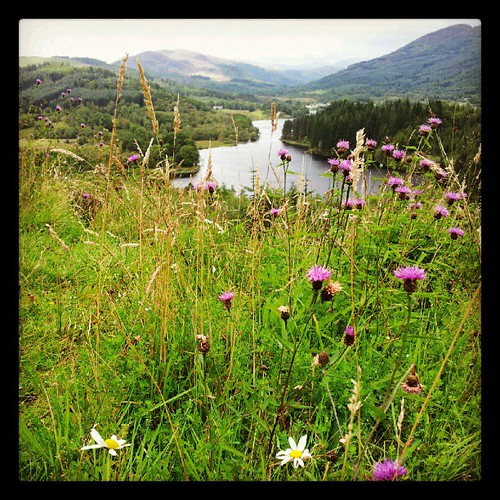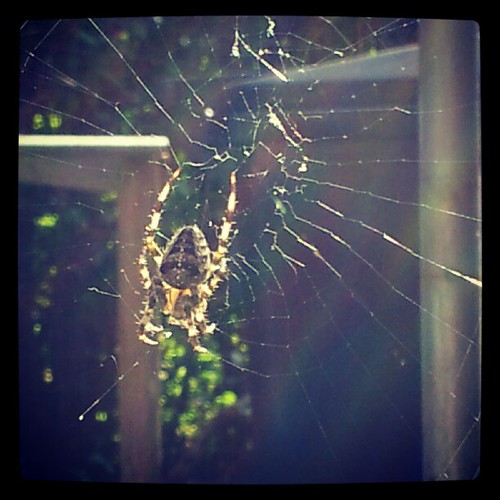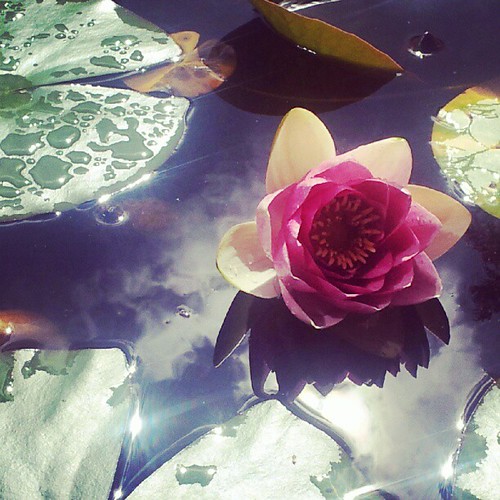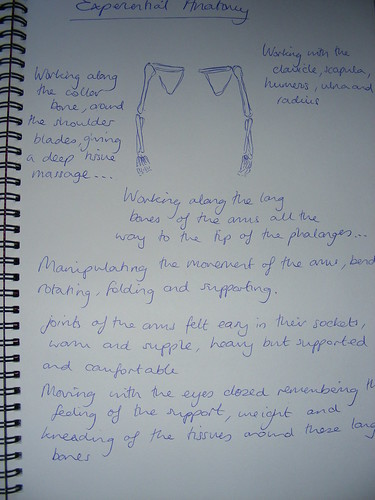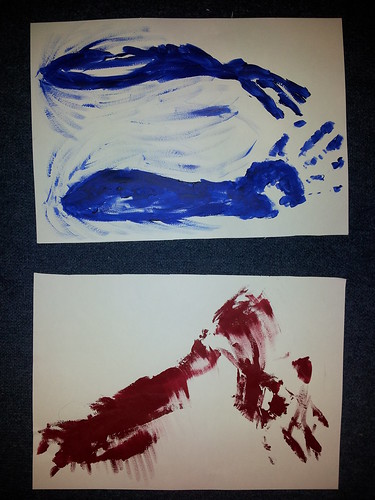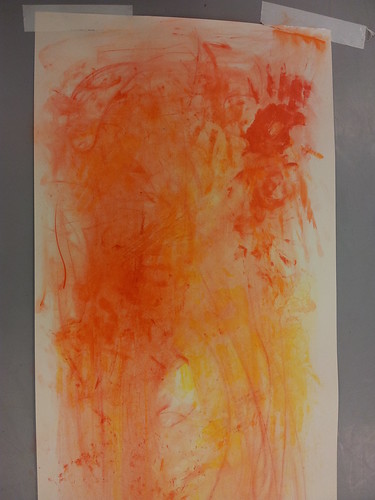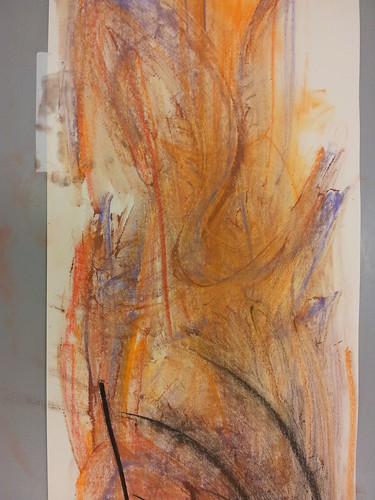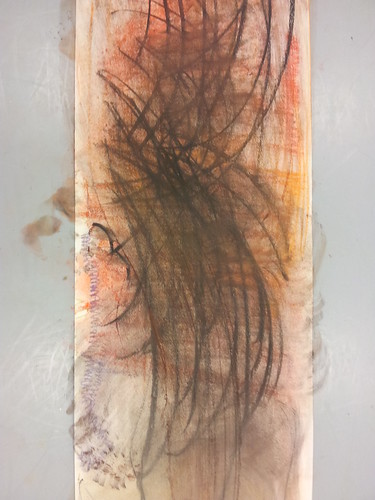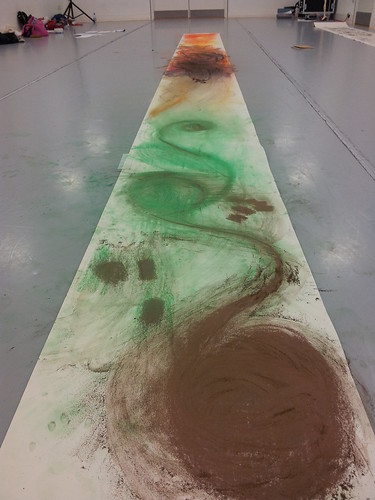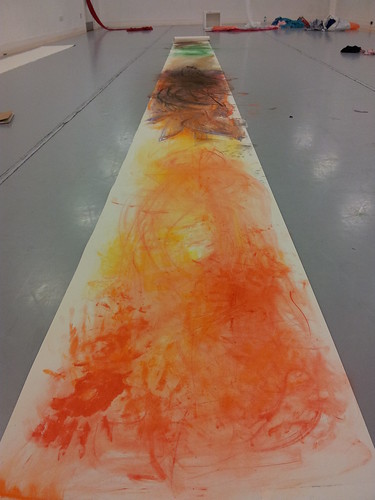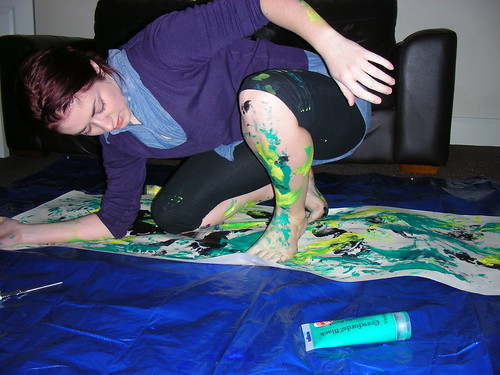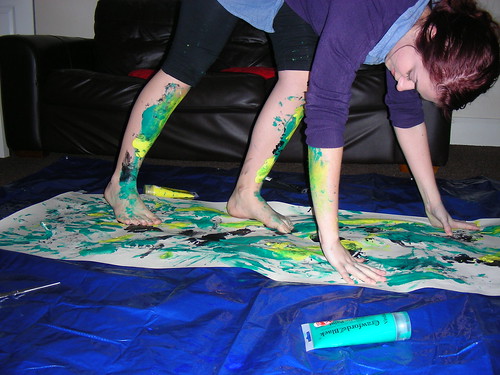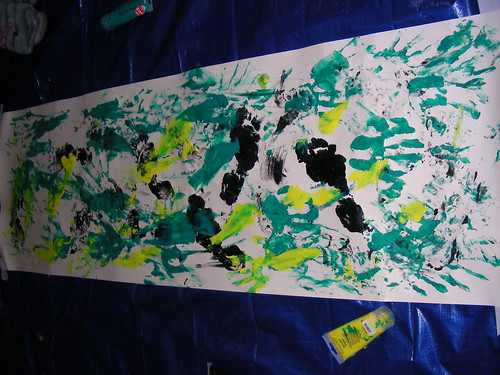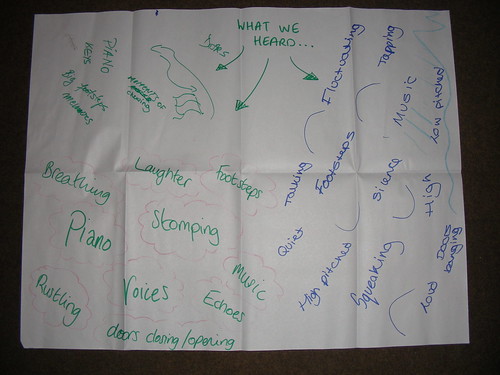During this post I would like to focus on my experience of beginning to understand and move through the practice of BMC.
Introduction to Senses and Perception
We are constantly receiving sensory information, of all kinds - sounds, smells, sights and so on - the interesting part is how we selectively filter them in our awareness. Shifting focus between one or another and then perhaps experimenting with a dual or multi-awareness. This can of course lead to a sensory overload and it is important to remember you can always take a step back!
For me, the difficulty was in letting go. Enjoying where the moment takes you, no matter where it originates from. It is hard to let go in a class situation. You are surrounded by peers and often have limited space to move fully. You are also more than likely being encouraged and observed by a teacher or lecturer. Being able to let go of the feeling that you should be moving a certain way and instead just allowing movement to happen is one of the key skills to be aware of and is a continuous process of learning and adapting.
Cellular Breathing
This idea of letting go and of melting, sinking into the floor as it rises up to support you are by now very familiar. This pattern however offers another layer of awareness. Bringing the knowledge of all my trillions of cells into my conscious awareness brought a greater sense of heaviness, of density, weight and volume. It reminded me of my 3D self, my solidity - as well as my fluidity. It reminded me of the time I spent last year in Performance Projects with Matthias Sperling. One of his favourite reminders for us while moving was to keep all our trillions of cells together - to not leave any behind us in the space.
This pattern also gave me a sense of pouring weight between the cells as I move - perhaps rolling and shifting a bean bag is a reasonable image for this sensation.
Naval Radiation Pattern - The Starfish
Like many people, I found this pattern the easiest to access. Perhaps because it appeals to my sense of symmetry and energy flow and centre awareness. The different sense of movement and proprioception it brings to my awareness is interesting coupled with an understanding of connectivity and integration of the whole self. We all build up movement patterns and our own movement style but it is sometimes useful to remember the equality of all 6 limbs of the body. Centre and periphery, core and distal movement. The image that I enjoyed most with this pattern is that it is not a one-directional flow of energy but an exchange of energy, a conversation with the environment immediately around us.
Mouthing Pattern - Sea Squirt
From the start of working with this movement pattern I was immediately aware of its deep emotional and instinctual connections. At first I thought I would turn away from the offered touch close to my mouth, however after a while I found it comforting and relaxing despite the intimacy of the process. The benefits of this pattern are very relevant for me I think, in reminding me that the spine is not our only form of vertical support. We have a much softer, fluid centre line through our digestive system that can also offer us support and guide us to a less rigid sense of movement.
Pre-spinal Pattern - The Lancelet
This stage really brought an awareness of the early developmental processes that we all as a species originate from. Seeing and visualising the different layers of support through the body - FRONT. MIDDLE. BACK.
The Notocord - The pre-cursor for the spine. And the Neural tube - The precursor for the spinal cord.
This stage brings an awareness to the sequential and fluid movement of the body through space.
Spinal Pattern - The Fish
It is good to remember first of all that this stage is still water-based in terms of its place the evolutionary chain. Something about this fact for me always makes me move differently. Perhaps it is a sense of floating and being supported from every angle as I move through space.
Head to tail connectivity. Soft spine and bony spine. By this stage the brain and spinal cord are protected by bony casings.
The fins of the fish are of course pre-cursors to limbs and act as both propulsion through space and stabilisers to aid balance. Finding support before moving into activity.
This was the hardest pattern for me to access and navigate. It brought up several queries for me;
Is yielding the same as the sensation of softening?
I found it difficult to move away from a feeling or compression rather than yielding. Collapsing rather than softening the body.
Monday 10 December 2012
Sunday 18 November 2012
The mouthing pattern
This was a very intimate process with deep emotional connections that we are perhaps only aware of at a subliminal level.
I thought I would turn away from the stroking, guiding hand next to the mouth, finding it too personal and invasive. However, I actually found it more comforting to go towards the touch, and felt a sense of loss when this warm contact was taken away.
The effect that this seemingly simple pattern has on my movement is amazing! It is a similar feeling to moving with an awareness of my head to tail connection, but it is altogether more relaxed, softer, less rigid. This pattern is useful in reminding us that the spine is not the only centre line through the body. We actually have a much more fluid and soft central column of support which is also constantly active at an unconscious level as we move through our day.
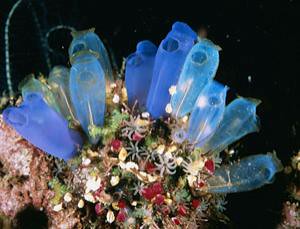
I thought I would turn away from the stroking, guiding hand next to the mouth, finding it too personal and invasive. However, I actually found it more comforting to go towards the touch, and felt a sense of loss when this warm contact was taken away.
The effect that this seemingly simple pattern has on my movement is amazing! It is a similar feeling to moving with an awareness of my head to tail connection, but it is altogether more relaxed, softer, less rigid. This pattern is useful in reminding us that the spine is not the only centre line through the body. We actually have a much more fluid and soft central column of support which is also constantly active at an unconscious level as we move through our day.

Naval radiation pattern
- Equality between the limbs - no one part of the 'starfish' is more important than another.
- Integration through the centre.
- Sense of energy in movement and proprioception. Connectivity to the whole self.
How can this movement pattern offer integration between the centre and periphery, the core and distal movement?
The most important point I find it helpful to remember is that this is not a one-way flow of energy. It is an exchange, a conversation between my core, through my six limbs out into my environment, just as much as it is about receiving information and feedback from my external environment and bringing this back in through my limbs to my centre.
- Integration through the centre.
- Sense of energy in movement and proprioception. Connectivity to the whole self.
How can this movement pattern offer integration between the centre and periphery, the core and distal movement?
The most important point I find it helpful to remember is that this is not a one-way flow of energy. It is an exchange, a conversation between my core, through my six limbs out into my environment, just as much as it is about receiving information and feedback from my external environment and bringing this back in through my limbs to my centre.
A moving and witnessing experience
Class exercise with Polly Hudson:
Hands on touch, partner provides pressure into the muscles and combing down the limbs.
Moving and partner witnessing
Both moving
Witnessing partner moves in response
Became very aware through hands on and beginning of moving of my volume and 3D presence in the space.
Folding, hugging and condensing, comfort and warmth.
Working in this class with a male dancer has given me a freshening of perspective. He has a different way of holding his body. Different structure. Different strengths. It has refreshed my perspectives in both moving and witnessing.
Hands on touch, partner provides pressure into the muscles and combing down the limbs.
Moving and partner witnessing
Both moving
Witnessing partner moves in response
Became very aware through hands on and beginning of moving of my volume and 3D presence in the space.
Folding, hugging and condensing, comfort and warmth.
Working in this class with a male dancer has given me a freshening of perspective. He has a different way of holding his body. Different structure. Different strengths. It has refreshed my perspectives in both moving and witnessing.
An example of documentation
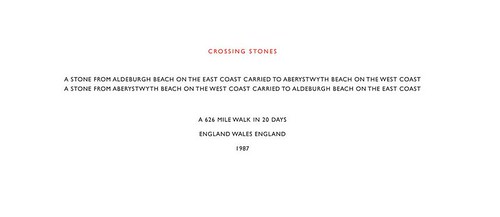 Documentation of work by Richard Long.
Taking something from one place to another and then swapping and replacing.
Displacement and replacement.
A sharing.
http://www.richardlong.org/
Documentation of work by Richard Long.
Taking something from one place to another and then swapping and replacing.
Displacement and replacement.
A sharing.
http://www.richardlong.org/
Saturday 3 November 2012
BMC links
"Touch is the other side of movement. Movement is the other side of touch. They are the shadow of each other" - Bonnie Bainbridge Cohen
http://www.bodymindcentering.com/blogs/touch-and-movement
http://www.heacademy.ac.uk/assets/Documents/disciplines/ddm/HEADDM-Bannon(2012)RelationalEthics.pdf
Tate Modern visit
Reflections and questions from our group visit to the Tate.
THE TANKS
What is live performance art? Does it have to even be seen live to be called live art?
Suzanne Lacy: The Crystal Quilt
- Women, over the age of 60. Speaking about what old age means to them, their expectations and perspectives.
- This work asked the question; Does art really challenge perspectives? Does it really change how people live their lives? Their attitudes towards the elderly?
Liz Rhodes: Light Music
- Two projectors facing each other. I could have stayed with this work a lot longer! The audience had the choice and ability to move and interact with the light and projections.
- This asked the question; Am I the audience or am I the performer in this work?
Sung Hwan Kim
- Video and performance art installation.
- The use of story-telling, myths and legends, the use of humour and an intriguing simplicity yet extraordinary depth to his work.
- collecting and collaging encounters, sounds, sculptures and images to create his work.
Throughout the rest of the gallery, the works that I found most intriguing or stimulating were the sculptures or 3D images or the multi-media pieces. In relation to our plans for FMP we began to think about what it would mean to interact with the art work. Drawing movement through inspiration and finding and then crossing that line between viewer and performer. Putting the body on display in the exhibition.
What is the role of documenting when creating our FMP?
THE TANKS
What is live performance art? Does it have to even be seen live to be called live art?
Suzanne Lacy: The Crystal Quilt
- Women, over the age of 60. Speaking about what old age means to them, their expectations and perspectives.
- This work asked the question; Does art really challenge perspectives? Does it really change how people live their lives? Their attitudes towards the elderly?
Liz Rhodes: Light Music
- Two projectors facing each other. I could have stayed with this work a lot longer! The audience had the choice and ability to move and interact with the light and projections.
- This asked the question; Am I the audience or am I the performer in this work?
Sung Hwan Kim
- Video and performance art installation.
- The use of story-telling, myths and legends, the use of humour and an intriguing simplicity yet extraordinary depth to his work.
- collecting and collaging encounters, sounds, sculptures and images to create his work.
Throughout the rest of the gallery, the works that I found most intriguing or stimulating were the sculptures or 3D images or the multi-media pieces. In relation to our plans for FMP we began to think about what it would mean to interact with the art work. Drawing movement through inspiration and finding and then crossing that line between viewer and performer. Putting the body on display in the exhibition.
What is the role of documenting when creating our FMP?
Thursday 1 November 2012
Naval Radiation Pattern
THE STARFISH
Human development. While in utero we are sustained and nourished by the umbilical cord. This of course feeds directly into our naval. Even once born, infants still have this intuitive and instinctual habit of curling around the naval and instigating movement from the centre of the body. As we grow and develop we tend to lose this connection.
Lying on our fronts, sinking and relaxing into the floor. Our parter witnesses our breathing and then places a hand where they see the breath as being most present. Then they find the position of the naval as if it was a bolt going through the core of the body and out into the floor. They then begin to trace and warm the tissues up the back and along the arms and then the legs, and then tracing up to he tip of the skull and down to the tail.
This was a fantastic image both to give and receive. First as a receiver, I felt really grounded by the connection to my naval and therefore my centre. The use of hands-on from my partner felt like energy pathways along each of my limbs and along the length of my spine. For me personally it began to feel less like a starfish and more like the wings of a dragonfly unfurling on my back, the veins of the wings reflecting the veins of my own body. Perhaps similar to the wings of a dragonfly, the energy I felt along my limbs felt fragile and yet strong at the same time. Moving with this awareness made me realise the full length of my limbs in the space and the connection of my head to my tail.

Human development. While in utero we are sustained and nourished by the umbilical cord. This of course feeds directly into our naval. Even once born, infants still have this intuitive and instinctual habit of curling around the naval and instigating movement from the centre of the body. As we grow and develop we tend to lose this connection.
Lying on our fronts, sinking and relaxing into the floor. Our parter witnesses our breathing and then places a hand where they see the breath as being most present. Then they find the position of the naval as if it was a bolt going through the core of the body and out into the floor. They then begin to trace and warm the tissues up the back and along the arms and then the legs, and then tracing up to he tip of the skull and down to the tail.
This was a fantastic image both to give and receive. First as a receiver, I felt really grounded by the connection to my naval and therefore my centre. The use of hands-on from my partner felt like energy pathways along each of my limbs and along the length of my spine. For me personally it began to feel less like a starfish and more like the wings of a dragonfly unfurling on my back, the veins of the wings reflecting the veins of my own body. Perhaps similar to the wings of a dragonfly, the energy I felt along my limbs felt fragile and yet strong at the same time. Moving with this awareness made me realise the full length of my limbs in the space and the connection of my head to my tail.

Cellular breathing
I love the image of the cells breathing. I still find it fascinating how many different functioning organelles can be packed into one cell. Our dense build-up.
Lying or sitting still, focusing on the breath in and out of the body and trying to have a sense of each individual cell of the body also condensing and expanding to their own rhythm. For me, it gives a real sense of volume and our 3D self.
When we then start to roll and shift, I had the image of the weight or fluid or some kind of mass pouring between the cells, influenced by gravity and a desire to melt into the floor.
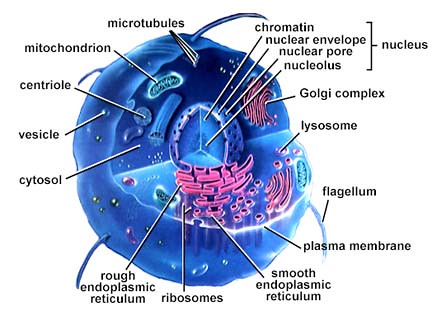
Lying or sitting still, focusing on the breath in and out of the body and trying to have a sense of each individual cell of the body also condensing and expanding to their own rhythm. For me, it gives a real sense of volume and our 3D self.
When we then start to roll and shift, I had the image of the weight or fluid or some kind of mass pouring between the cells, influenced by gravity and a desire to melt into the floor.

Sunday 21 October 2012
Reflections on BMC practice
Reflections from BMC reading: Andrea Olsen, 'Body and Earth'
The use of touch in BMC practice...
To know through touch... is to understand better... the ways in which lines of communication between human beings and all other forms of organic and inorganic life can remain open if the currents that run through the hand are encouraged to flow.
Michael Brenson, 'Memory of the Hand', Sculpture Magazine
The sensorial information we recieve through touch allows us to orientate ourselves to our outward, external environment as well as our inward, internal world.
I think it is important to remember that the thickness of our skin varies over different parts of the body.
'The skin of an adult's body weighs about eight pounds, with a thickness varying from a few epithelial cells on the eyelids or behind the ears to ten or more touch layers on the soles of our feet.'
'Our bodies are longing to move and to shake out excess tension - to tremble, stretch, or wriggle in discovery and recovery.'
This becomes the role and importance of BMC practice. Scirntific studies have conclusive evidence on the benefits of movement and touch through a child's development. It is esssential to both physical and emotional health.
Skin is involved in many of the key processes that regulate our internal environment. 'In its living, breathing exchange with the environment, skin informs our concept of what exists outside and what exists inside the body, shaping our identity and our capacity for distinction of self and other.'
The use of touch in BMC practice...
To know through touch... is to understand better... the ways in which lines of communication between human beings and all other forms of organic and inorganic life can remain open if the currents that run through the hand are encouraged to flow.
Michael Brenson, 'Memory of the Hand', Sculpture Magazine
The sensorial information we recieve through touch allows us to orientate ourselves to our outward, external environment as well as our inward, internal world.
I think it is important to remember that the thickness of our skin varies over different parts of the body.
'The skin of an adult's body weighs about eight pounds, with a thickness varying from a few epithelial cells on the eyelids or behind the ears to ten or more touch layers on the soles of our feet.'
'Our bodies are longing to move and to shake out excess tension - to tremble, stretch, or wriggle in discovery and recovery.'
This becomes the role and importance of BMC practice. Scirntific studies have conclusive evidence on the benefits of movement and touch through a child's development. It is esssential to both physical and emotional health.
Skin is involved in many of the key processes that regulate our internal environment. 'In its living, breathing exchange with the environment, skin informs our concept of what exists outside and what exists inside the body, shaping our identity and our capacity for distinction of self and other.'
Film Module progress
I have been home to collect some of the objects and possessions I took with me to places like Peru, Scotland and Berlin.
These items are important to me. They carry memories. They carry a spark, a reminder of what it was like to travel; who I met along the way; the sights that I saw; what challenges I faced and what I accomplished.
Moving from the memory of these objects as well as photographs makes this investigation a very personal and emotional process.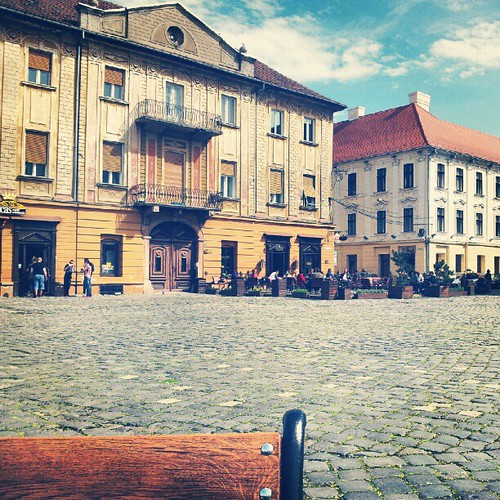 Spring 2012 Timisoara, Romania
Spring 2012 Timisoara, Romania
These items are important to me. They carry memories. They carry a spark, a reminder of what it was like to travel; who I met along the way; the sights that I saw; what challenges I faced and what I accomplished.
Moving from the memory of these objects as well as photographs makes this investigation a very personal and emotional process.
 Spring 2012 Timisoara, Romania
Spring 2012 Timisoara, Romania
Wednesday 3 October 2012
Theme for FMP
Travelling
Journey
Adventure
Exploration
Nomadic
Drifting
Roving
Wandering
Roaming
Voyage
Expedition
Excursion
Quest
Venture
For my FMP I want to focus on the theme of travelling and adventure.
What drives us to seek out adventure?
The awe-inspiring power of the natural landscape and it's beautiful ability to return the mind to a state of peace and tranquility.
Ideas for Locations: Woodland, Coast, Moorland, Mountain-side, Parkland, River-side, Lake-side...
Could this also include the people I meet along the way? Some say it is the people you meet when travelling who make it an adventure.
Their are also a number of parallels to be drawn between a journey through the landscape and a journey you make when dancing and creating. Finding new pathways. Discovering new interests.
Journey
Adventure
Exploration
Nomadic
Drifting
Roving
Wandering
Roaming
Voyage
Expedition
Excursion
Quest
Venture
For my FMP I want to focus on the theme of travelling and adventure.
What drives us to seek out adventure?
The awe-inspiring power of the natural landscape and it's beautiful ability to return the mind to a state of peace and tranquility.
Ideas for Locations: Woodland, Coast, Moorland, Mountain-side, Parkland, River-side, Lake-side...
Could this also include the people I meet along the way? Some say it is the people you meet when travelling who make it an adventure.
Their are also a number of parallels to be drawn between a journey through the landscape and a journey you make when dancing and creating. Finding new pathways. Discovering new interests.
Sunday 30 September 2012
Thoughts and ponderings...
I am an explorer.
I have a need for adventure. A craving. An itch, if you will.
To dance is to discover and explore. It is a journey that continues to surprise and enthral.
It can take you along rivers of thought and through the dense forests of knowledge. It can challenge you to the mountainous highs and the deep valley lows of discovery and success.
To share it with others is part of the thrill.
I have a need for adventure. A craving. An itch, if you will.
To dance is to discover and explore. It is a journey that continues to surprise and enthral.
It can take you along rivers of thought and through the dense forests of knowledge. It can challenge you to the mountainous highs and the deep valley lows of discovery and success.
To share it with others is part of the thrill.
Sunday 23 September 2012
Monday 17 September 2012
'A new start'
Perhaps it is unsurprising that I found my second year a challenge to say the least. Dealing with the stresses of illness, fatigue and at times depression, made it difficult to maintain any kind of organisation, work ethic or creative drive that I had prided myself on in the years before. This summer break has allowed me to re-connect with my family and enjoy a lifestyle away from the city and from the university where I have spent so much of my time. Fortunate as I am to live in the countryside, surrounded by fields, hills and woodland, I felt able to draw a real sense of peace and tranquillity from my surroundings. I guess the most appropriate word for this is PERSPECTIVE. A reminder that I am a tiny part of this ever-changing world and it is up to me to make the best of it. Perhaps there is a certain level of irony in the fact that it was the reminder of my own mortality that brought me 'back to life'.
It is this refreshed 'perspective' that gives me the push I need to send me in to what I hope will be my most productive, creative, motivating and challenging year yet!
To think that this time next year I will have finished my degree and will be searching for my next challenge fills me with an ambivalent mixture of excitement and dread!
My theme for this next year of work will be the notion of travel, adventure, and what drives us to reach for new places, new challenges...
Perhaps most important to me is the concept of site and space, whether this means returning to that ever-present pull of the natural environment, in the fields, woods, hills and coastline that I love so much, or perhaps the draw of more urban, unused spaces...
How does our choice of space and site impact on our creative choices?
How does our choice of space and site effect how our work is viewed by others?
It is this refreshed 'perspective' that gives me the push I need to send me in to what I hope will be my most productive, creative, motivating and challenging year yet!
To think that this time next year I will have finished my degree and will be searching for my next challenge fills me with an ambivalent mixture of excitement and dread!
My theme for this next year of work will be the notion of travel, adventure, and what drives us to reach for new places, new challenges...
Perhaps most important to me is the concept of site and space, whether this means returning to that ever-present pull of the natural environment, in the fields, woods, hills and coastline that I love so much, or perhaps the draw of more urban, unused spaces...
How does our choice of space and site impact on our creative choices?
How does our choice of space and site effect how our work is viewed by others?
Monday 18 June 2012
Monday 19 March 2012
The Underscore
Working in a totally different way today felt so refreshing and available for my brain and body! There are so many layers to the Underscore I felt like I wanted more time to access them and really become involved with them.
The logical sequence of the delivery was very appealing to my way of moving and thinking.
I faced the challenges today of being aware of my comfort zones - either being very close to the floor or standing are most comfortable for me - the mid-levels I find more challenging to move through and this is where I tend to rush! I also felt like I wanted to work more independently today so when it came to the moment for contact or touch or confluence I would try to become absorbed by the other person's movement but would only stay in the group for a couple of minutes before going back out into the space to get back into my body, working on my own kinaesphere.
I very much enjoyed the concept of grazing, selectively choosing to be attracted to someone or something or to be repelled or to instigate contact, or to intersect another's movement...
What is Underscore?
The Underscore is a long score for jamming/composition/contact/improvisation. The Underscore guides us through a progression of “changing states” of body and mind—from solo sensitizing to gravity and support, into group circulation and Contact Improvisation engagements, opening out into whole room compositional awareness and interaction, and back to rest and reflection. Developed by Nancy Stark Smith the Underscore is a popular practice among contact dancers all around the world. “The Underscore is a framework for practicing and researching dance improvisation… It is a score that guides dancers through… “changing states” of mind and body…(which) can be seen as a vehicle for incorporating Contact Improvisation into a broader arena of improvisational practice; for developing greater ease dancing in spherical space—alone and with others; and for integrating kinesthetic and compositional concerns while improvising. The Underscore is also being used in the CI community worldwide as a way to focus and concentrate Contact jams.”
The logical sequence of the delivery was very appealing to my way of moving and thinking.
I faced the challenges today of being aware of my comfort zones - either being very close to the floor or standing are most comfortable for me - the mid-levels I find more challenging to move through and this is where I tend to rush! I also felt like I wanted to work more independently today so when it came to the moment for contact or touch or confluence I would try to become absorbed by the other person's movement but would only stay in the group for a couple of minutes before going back out into the space to get back into my body, working on my own kinaesphere.
I very much enjoyed the concept of grazing, selectively choosing to be attracted to someone or something or to be repelled or to instigate contact, or to intersect another's movement...
What is Underscore?
The Underscore is a long score for jamming/composition/contact/improvisation. The Underscore guides us through a progression of “changing states” of body and mind—from solo sensitizing to gravity and support, into group circulation and Contact Improvisation engagements, opening out into whole room compositional awareness and interaction, and back to rest and reflection. Developed by Nancy Stark Smith the Underscore is a popular practice among contact dancers all around the world. “The Underscore is a framework for practicing and researching dance improvisation… It is a score that guides dancers through… “changing states” of mind and body…(which) can be seen as a vehicle for incorporating Contact Improvisation into a broader arena of improvisational practice; for developing greater ease dancing in spherical space—alone and with others; and for integrating kinesthetic and compositional concerns while improvising. The Underscore is also being used in the CI community worldwide as a way to focus and concentrate Contact jams.”
—Nancy Stark Smith, from Caught Falling
Saturday 17 March 2012
SRT class
Extract from journal: 22-02-12
Gliding...
supple feet through
the space
softening
through the
legs and
up into the hips,
ribs, shoulders, arms,
neck and skull.
Skull floating
Upper body
suspended
legs hanging
melting...
into the floor.
Gossamer threads
appear...
energy between the
fingertips
soft, supple motion
taking you in and
out of
the floor
Articulate bodies
and warm, soft
focus...
Real connection...
Gliding...
supple feet through
the space
softening
through the
legs and
up into the hips,
ribs, shoulders, arms,
neck and skull.
Skull floating
Upper body
suspended
legs hanging
melting...
into the floor.
Gossamer threads
appear...
energy between the
fingertips
soft, supple motion
taking you in and
out of
the floor
Articulate bodies
and warm, soft
focus...
Real connection...
Contact Improv with Charlie Morrissey
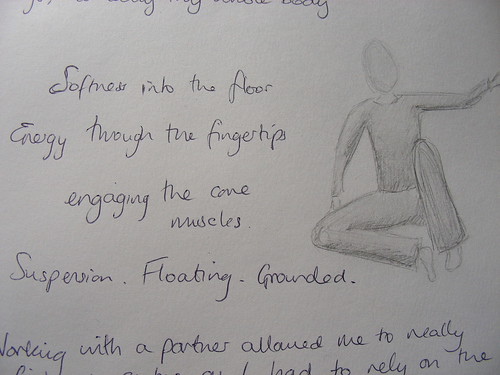 Though I was ill today and couldn't really engage with my movement as I would have liked, I found this class really fantastic to move through. I had a real softness today in my feet and legs.
Working with a partner allowed me to really find my centre as I couldn't just rely on the other person to support me. Sometimes of course 'mistakes' happen or something that we don't expect - but these moments are when we find a true connection to our movement and that of our partner, and when I needed my core and softness in the joints to keep me safe and allow me to either stay upright or melt to the floor...
Though I was ill today and couldn't really engage with my movement as I would have liked, I found this class really fantastic to move through. I had a real softness today in my feet and legs.
Working with a partner allowed me to really find my centre as I couldn't just rely on the other person to support me. Sometimes of course 'mistakes' happen or something that we don't expect - but these moments are when we find a true connection to our movement and that of our partner, and when I needed my core and softness in the joints to keep me safe and allow me to either stay upright or melt to the floor...
Phrase Class
Extract from journal: 30-01-12
The window-like spaces in the spine can be opened and massaged not only from the back of the spine but also along the front face of the vertebrae - deep within the centre of the body...
Valleys of the joints of the legs can be softened and opened. Breathing into these spaces can help us...
The window-like spaces in the spine can be opened and massaged not only from the back of the spine but also along the front face of the vertebrae - deep within the centre of the body...
Valleys of the joints of the legs can be softened and opened. Breathing into these spaces can help us...
SRT class
Finding a connection with the breath... the skin... the contact with the floor beneath your feet... the skull floating... the legs hanging... the joints of the hips softening...
Balance and shift through the space, balance and shift through the space.
Really settled into an easy way of moving. Felt like I had grown and could balance forever!
Balance and shift through the space, balance and shift through the space.
Really settled into an easy way of moving. Felt like I had grown and could balance forever!
Journal entry
Improvisation
Extract from journal: 10-01-12
Moving with a partner... I became more fluid, grounded... I found myself drawn more to leading than following... I enjoyed the moments of accidental contact... I found the music a hindrance at first as it was quite slow... but began to pick up pace in my own body and really gained focus with a change of pace and travelling...
Moving with a partner... I became more fluid, grounded... I found myself drawn more to leading than following... I enjoyed the moments of accidental contact... I found the music a hindrance at first as it was quite slow... but began to pick up pace in my own body and really gained focus with a change of pace and travelling...
Phrase Class
Extract from journal: 09-01-12
Travelling across the space... collecting the colours of your movement each time you cross the space...
Travelling across the space... collecting the colours of your movement each time you cross the space...
Friday 16 March 2012
Term 2 overview
I have been very excited by the turn my own practise has taken over the course of my second term. The main focus of my work has been my interdisciplinary practise. In preparation for my assessment module I have been researching a large range of artists from cross-disciplinary backgrounds, as well as visual artists. At the moment I am exploring the line of installation art - I am particularly inspired by the work of Cornelia Parker!
http://www.frithstreetgallery.com/artists/works/cornelia_parker
In my movement studies classes I have been continuing to develop my practise in the following areas:
A greater understanding of the use of the breath when moving.
Maintaining an awareness of the space and people around me, even while working with complex, personal, internal imagery.
Moving with an awareness of the back surfaces of the body as well as the front surfaces.
I am particularly enjoying the continuation of our Skinner Releasing classes. Even though it is a much softer, more calming class environment physically, it always gives me a huge range of images to work with and I enjoy the sense of build up with each class!!
http://www.frithstreetgallery.com/artists/works/cornelia_parker
In my movement studies classes I have been continuing to develop my practise in the following areas:
A greater understanding of the use of the breath when moving.
Maintaining an awareness of the space and people around me, even while working with complex, personal, internal imagery.
Moving with an awareness of the back surfaces of the body as well as the front surfaces.
I am particularly enjoying the continuation of our Skinner Releasing classes. Even though it is a much softer, more calming class environment physically, it always gives me a huge range of images to work with and I enjoy the sense of build up with each class!!
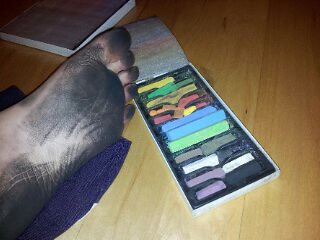 Starting to explore using pastels in my IPP investigations. Pastels have a lovely texture and organic feel to them that I really enjoy working with. They can crumble and turn to powder on the paper. They can be sharp and vibrant or soft and subtle. They can smudge and rub in and blend and blur...
Starting to explore using pastels in my IPP investigations. Pastels have a lovely texture and organic feel to them that I really enjoy working with. They can crumble and turn to powder on the paper. They can be sharp and vibrant or soft and subtle. They can smudge and rub in and blend and blur...
 Great for using on the feet to leave footprint traces across the paper!
Great for using on the feet to leave footprint traces across the paper!
 I can perhaps begin to add layers to this work... using different materials, different colours...
I can perhaps begin to add layers to this work... using different materials, different colours...
IPP2 Questions
So when trying to finalise the direction I want my IPP2 exploration to take I needed to consider what I was truly inspired by and interested in. I have a keen interest in the visual arts, and in particular in installation art - I enjoy the idea of something being created in the space and left to remain long after the initial 'performance' has finished.
Is it durational?
Is there a beginning and an end?
Is something already in the space or do I make it during the performance?
Do the audience walk around the space?
Do the audience influence the piece? Can they interact with it?
What messages or images do I want to communicate?
Is it durational?
Is there a beginning and an end?
Is something already in the space or do I make it during the performance?
Do the audience walk around the space?
Do the audience influence the piece? Can they interact with it?
What messages or images do I want to communicate?
IPP2
IPP2
Developing a piece of work to be shown 6th March 2012
My inspirations:
Yves Klein

Angela White

With these pieces I love the dynamic and energetic qualities of the images, created with paint and movement. I would like to explore using paint and other mediums in my own work.
My inspirations:
Yves Klein

Angela White

With these pieces I love the dynamic and energetic qualities of the images, created with paint and movement. I would like to explore using paint and other mediums in my own work.
Sunday 22 January 2012
Gabriele Reuter performance
Ellen Terry 19-01-12
'Inventory'
It initially felt slightly surreal to witness a performance by a professional artist with so much experience and understanding of performance in a space that I knew so well. This was a space that I primarily know a practice space, not a performance space.
When expected to write an essay on what I saw in this performance I find it very hard to do so without first getting my thoughts, impressions, feelings, moods down in my own way... so here we go.
Having done some rather brief research into the work of Gabby Reuter, I was able to go into the performance with a little prior knowledge and understanding of what might happen. Was this an advantage or a disadvantage? I'm not entirely sure. To have pre-conceptions is not always the most useful thing. But I shall move on.
At ease in the space and confident both in her movement and her words, Gabby walks onto stage very close to the audience and addresses everyone as if they are already acquaintances. Her comfortable manner and use of humour gives her the presence of a story-teller or a narrator. The audience feel safe in the knowledge that she knows exactly what will happen and when. Gabby proceeds to split the space into different 'pockets' of meaning, creating wonderful images for the audience to indulge in. The ratio between her movement and use of text is beautifully balanced throughout the piece. Her openness and candour is refreshing and captivating for an audience. I know myself that I didn't want it to end! And this, I think, is all I am going to tell you for now. The piece is still going round in my head. I believe, however, that it is safe to say I thoroughly enjoyed this performance...!
http://www.gabrielereuter.de/
'Inventory'
It initially felt slightly surreal to witness a performance by a professional artist with so much experience and understanding of performance in a space that I knew so well. This was a space that I primarily know a practice space, not a performance space.
When expected to write an essay on what I saw in this performance I find it very hard to do so without first getting my thoughts, impressions, feelings, moods down in my own way... so here we go.
Having done some rather brief research into the work of Gabby Reuter, I was able to go into the performance with a little prior knowledge and understanding of what might happen. Was this an advantage or a disadvantage? I'm not entirely sure. To have pre-conceptions is not always the most useful thing. But I shall move on.
At ease in the space and confident both in her movement and her words, Gabby walks onto stage very close to the audience and addresses everyone as if they are already acquaintances. Her comfortable manner and use of humour gives her the presence of a story-teller or a narrator. The audience feel safe in the knowledge that she knows exactly what will happen and when. Gabby proceeds to split the space into different 'pockets' of meaning, creating wonderful images for the audience to indulge in. The ratio between her movement and use of text is beautifully balanced throughout the piece. Her openness and candour is refreshing and captivating for an audience. I know myself that I didn't want it to end! And this, I think, is all I am going to tell you for now. The piece is still going round in my head. I believe, however, that it is safe to say I thoroughly enjoyed this performance...!
http://www.gabrielereuter.de/
Inspirations and interests...
Listening to a Crossing Borders talk by Miranda Tufnell and Eva Karczag, I was struck by their very similar work ethic and views on the importance on understanding the body. They also mentioned this film by Anna Halprin as something to see! The trailer certainly looks interesting!
http://www.independentdance.co.uk/what/exchanges/crossing-borders-talks.htm
Subscribe to:
Posts (Atom)
